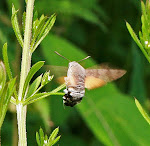The continuing hot sunny weather provided an opportunity to visit the only locality in England other than in the south for this butterfly. The site at Prees Heath is open common heathland where conservationists have done much work in supporting the butterfly.
.jpg)
.jpg)
Prees Heath lies between two Roman roads and has many historical connections. The area was once used as a Bronze Age burial ground whilst for many years a gallows was established there and was the site of one of the last public hangings in England. In the thirteenth century it was a muster point for King John's army when he invaded Wales and later it was used by Prince Rupert for the same purpose in the Civil War. During the twentieth century's two World Wars there was further military activity as an airfield, a training ground, and an internment camp.
.jpg)
The whole heath is flat and in those places where the butterfly if found is covered with light scrub and heather (the larval foodplant). Silver-studded Blues are in evidence from mid-June into July and on this occasion, in the warm sunny conditions, up to ten could be seen in flight at the same time.
.jpg)
.jpg)
[Taking nectar from heather flowers]
The butterfly's name derives from the small silver 'studs', actually bluish, present inside the black spots towards the edge of the under side of the hind wing. In some butterflies most of the spots are studded, in others just a few. The upper side of the wing has a pronounced dark margin. The males are bright blue but the females are duller and often brownish.
.jpg)
[The silvery-blue 'studs' are visible in the photo]
.jpg)
.jpg)
.jpg)
.jpg)
[Female low down in the vegetation searching for an egg-laying site]
.jpg)






No comments:
Post a Comment